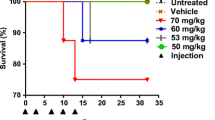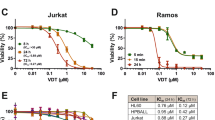Summary
Mice treated with lethal doses of adriamycin (A1) (IP) are rescued with a single IP dose of 3,5,5-trimethyl-2-morpholinon-3-yl radical dimer (TM3). The in vivo rescue is assumed to be analogous to the in vitro reaction of TM3 with A1 that produces the non-toxic 7-deoxy-adriamycinone (7dAone). TM3 prevents death if given within 60 min following A1 administration. Control A1-treated mice died by 8 days (median survival time) whereas TM3 rescued A1-treated mice had a median survival time of greater than 60 days.
Similar content being viewed by others
References
Bachur NR, Gordon SL, Gee MV (1977) Anthracycline antibiotic augmentation of microsomal electron transport and free radical formation. Mol Pharmacol 13: 901
Bachur NR, Gordon SL, Gee MV (1978) A general mechanism for microsomal activation of quinone anticancer agents to free radicals. Cancer Res 38: 1845
Barone AD, Atkinson RF, Wharry DW, Koch TH (1981) In vitro reactivity of meso and dl dimers of the 3,5,5-trimethyl-2-oxomorpholin-3-yl radical with adriamycin and daunomycin. J Am Chem Soc 103: 1606
Bertazzoli C, Ghione M (1977) Adriamycin-associated cardiotoxicity: Research on prevention with coenzyme. Q. Pharmacol Res Commun 9: 235
Bonadonna G, Beretta G, Tancini G, Brambilla C, Bajetta E, DePalo GM, DeLena M, Bellani FF, Gasparini M, Valagussa P, Veronesi U (1975) Adriamycin (NSC 123127) Studies at the Instituto Nazionale Tumori, Milan. Cancer Chemother Rep [3] 6: 231
Cruz, FS, Docampo R, Boveris A (1978) Generation of superoxide anions and hydrogen peroxide from β-lapachone in bacteria. Antimicrob Agents Chemother 14: 630
Docampo R, Cruz FS, Boveris A, Muniz RPA, Esquivel DMS (1979) β-Lapachone enhancement of lipid peroxidation and superoxide anion and hydrogen peroxide formation by sarcoma 180 ascites tumor cells. Biochem Pharmacol 28: 723
Henderson CA, Metz EN, Balcerzak SP, Sagone AL (1978) Adriamycin and daunomycin generate reactive oxygen compounds in erythrocytes. Blood 53: 878
Koch TH, Olesen JA, DeNiro J (1975) Photochemical reactivity of imino lactones. Photoreduction and photoelimination. J Org Chem 40: 14
Lown JW, Sim S, Chen H (1978) Hydroxyl radical production by free and DNA bound aminoquinone antibiotics and its role in DNA degradation. Electron spin resonance detection of hydroxyl radicals by spin trapping. Can J Biochem 56: 1042
Martini A, Donelli MG, Maniovani A, Pacciarini MA, Forgar-Ottaviano E, Morasca L, Garattini S, Spreafico F (1977) Antineoplastic activity and pharmacokinetics of adriamycin and daunomycin in tumor-bearing mice. Oncology 34: 173
Mimnaugh EG, Siddik ZH, Drew R, Sikic BI, Gram TE (1979) The effects of alpha-tocopherol and the toxicity, disposition, and metabolism of adriamycin in mice. Toxicol Appl Pharmacol 49: 119
Myers CE, McGuire WP, Young RC (1976) Adriamycin: Amelioration of toxicity by α-tocopherol. Cancer Treat Rep 60: 961
Myers CE, McGuire WP, Liss RH, Ifrim I, Grotziger K, Young RC (1977) Adriamycin: The role of lipid peroxidation in cardiac toxicity and tumor response. Science 197: 165
Remers WA (1979) The chemistry of anti-tumor antibiotics. Vol 1. John Wiley & Sons, New York, pp 63–132
Sonneveld P (1978) Effect of α-tocopherol on the cardiotoxicity of adriamycin in the rat. Cancer Treat Rep 62: 1033
Tong GL, Henry DW, Acton EM (1979) 5-Iminodaunorubicin. Reduced cardiotoxic properties in an antitumor anthracycline. J Med Chem 22: 36
Tong GL, Wu HY, Smith TH, Henry DW (1979) Adriamycin analogues. 3. Synthesis of N-alkylated anthracyclines with enhanced efficacy and reduced cardiotoxicity. J Med Chem 22: 912
Author information
Authors and Affiliations
Additional information
We dedicate this paper to the memory of Dr. Solomon Garb of the AMC Cancer Research Center and Hospital
Rights and permissions
About this article
Cite this article
Banks, A.R., Jones, T., Koch, T.H. et al. Prevention of adriamycin toxicity. Cancer Chemother. Pharmacol. 11, 91–93 (1983). https://doi.org/10.1007/BF00254252
Received:
Accepted:
Issue Date:
DOI: https://doi.org/10.1007/BF00254252




